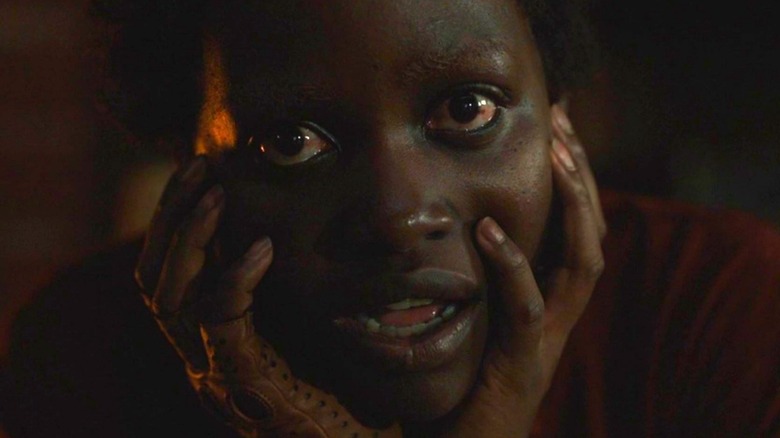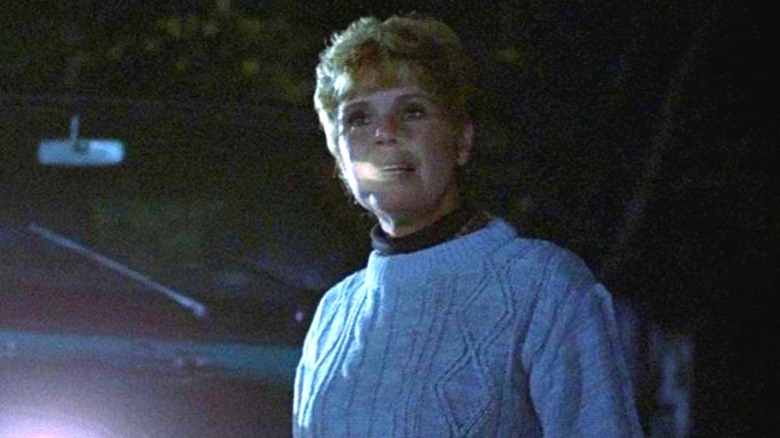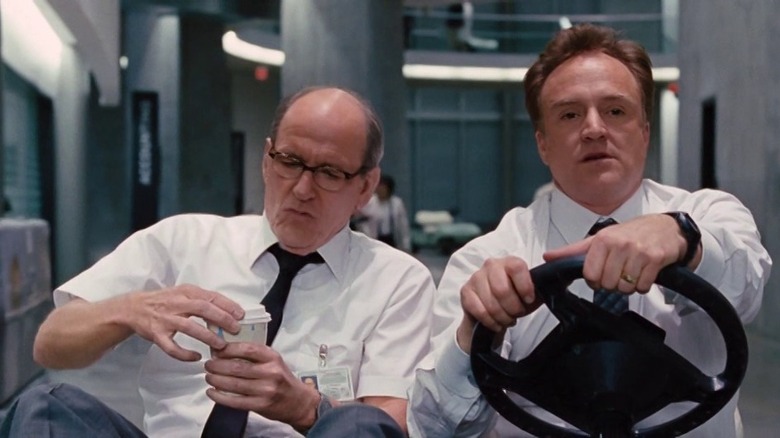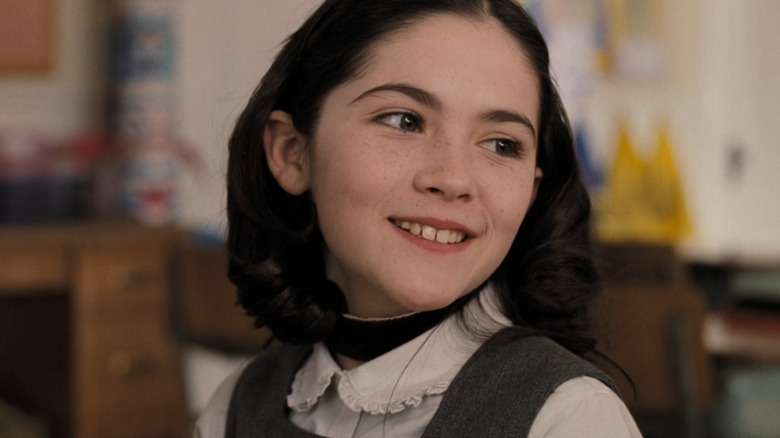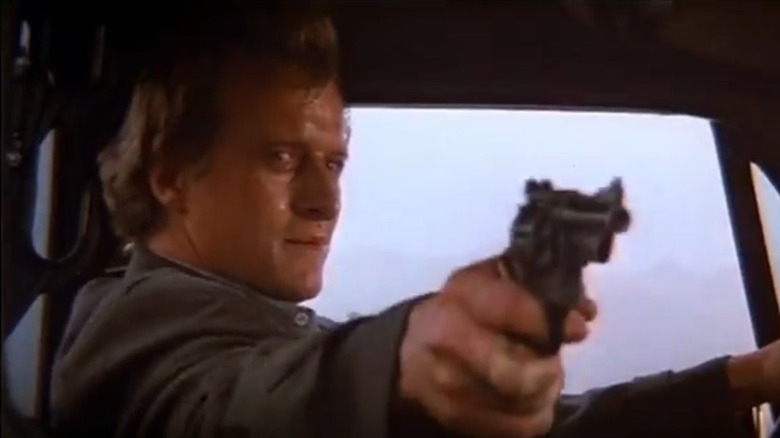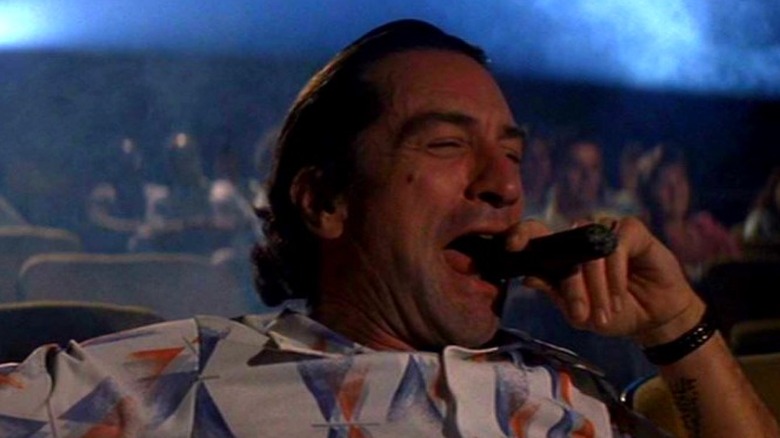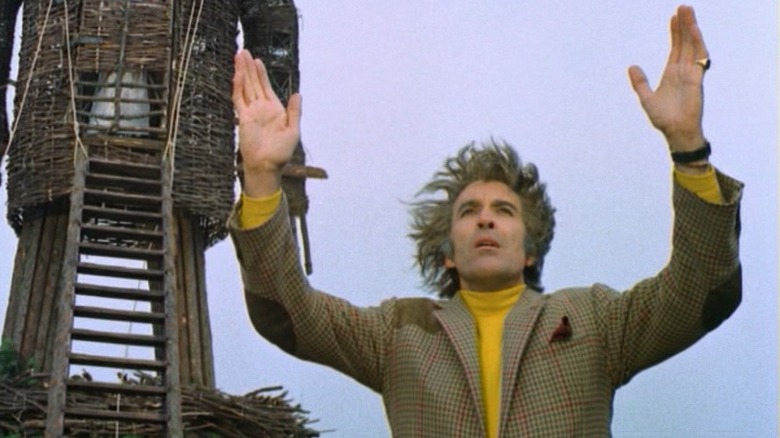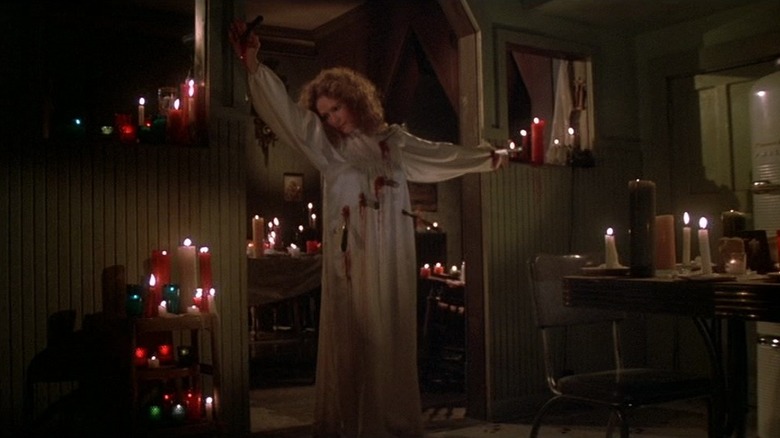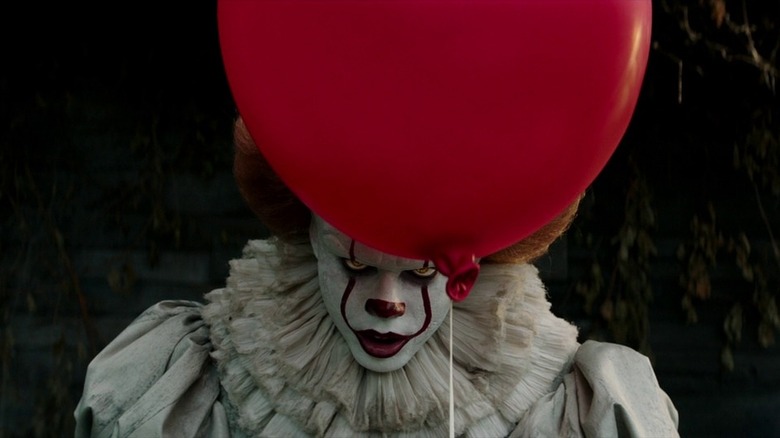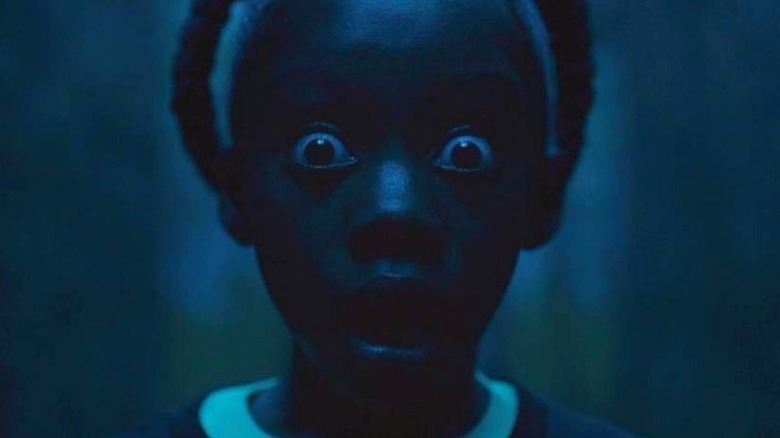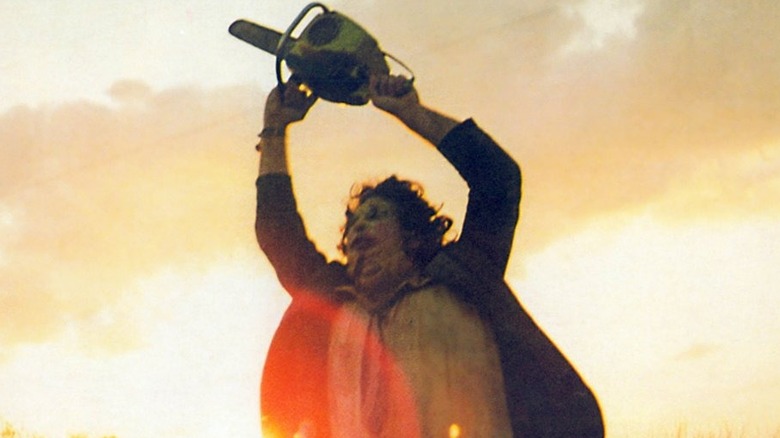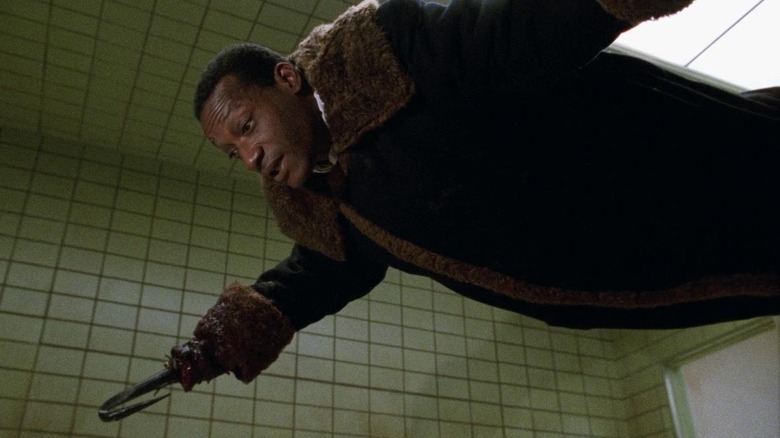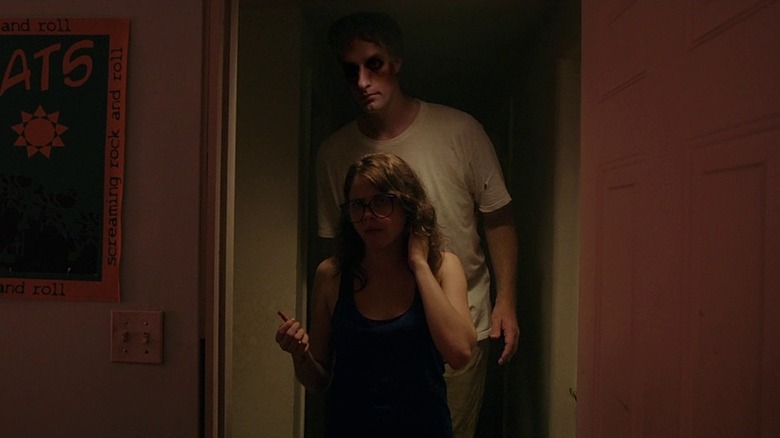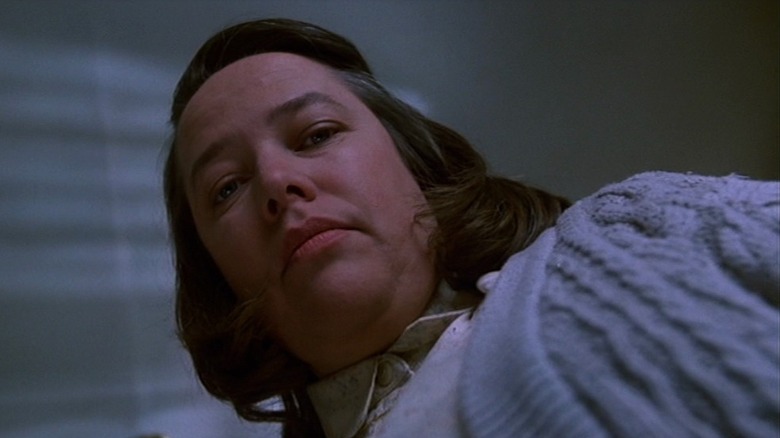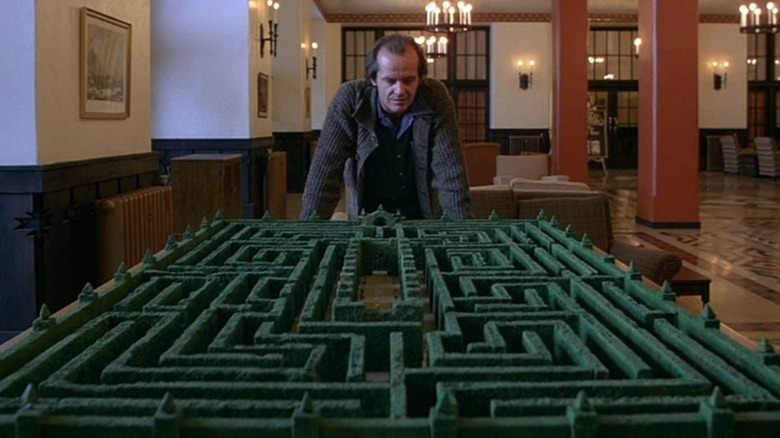Horror Villain Origin Stories We Want To See Onscreen
There are lots of lackluster villain origin stories, and we've all run into at least one that's disappointed us by retreading familiar ground or trying to explain too much. But that doesn't mean the whole idea is bad — we actually think it can be amazing. In some cases, we've held out hope for years that the right filmmaker would come along and deliver a back-story movie that feels as vital and lively as the original. Occasionally, comics or tie-in novels will scratch some of this itch, but we still want the treat of a full-length film.
We've assembled a wish list of the horror villain origin stories we crave the most. Sometimes we want elaborate world-building deep enough to splash around in, sometimes we want to see the moment where once-sympathetic characters go dark, and sometimes we just want the missing adventures of someone too horribly fun to leave behind. In all cases, though, we're talking about villains of preexisting movies – which often means talking about what they did there and what happened to them, so we should note that spoilers abound.
Pamela Voorhees from Friday the 13th
Before her son ever picked up a hockey mask and machete, Pamela Voorhees was terrorizing the counselors at Camp Crystal Lake: a role model for female slasher villains everywhere.
"Friday the 13th" makes Pamela's motivations clear. Those camp counselors who were too busy with each other to save her son from drowning? They're going down, and the camp's gates are staying shut for good. But what was Pamela doing during the time Camp Crystal Lake was shut down? We have trouble believing she just turned off her murderous urges completely.
And let's not forget the fact that "Jason Goes to Hell" reveals she had a copy of the Necronomicon from "The Evil Dead." Director Adam Marcus revealed to Horror Geek Life that he snuck that Easter egg in on purpose to try to make Jason's mythology a little more coherent, solving the problem of why this drowned child had somehow become a nearly indestructible adult man: "I think it's more fun if I have the Necronomicon in Pamela Voorhees' house. She makes a deal with the devil by reading from the Necronomicon to bring back her son. This is why Jason isn't Jason. He's Jason plus 'The Evil Dead.'" So yeah — a deal with the devil? There's definitely a story here.
The facility from The Cabin in the Woods
The postmodern horror-comedy "The Cabin in the Woods" raises a lot of questions about empathy, horror tropes, sacrificing for the greater good, and why you'd have a button that would release hordes of monsters right into your workspace. And there's potential for a juicy prequel that could explore all of that: Give us the back-story of the facility.
This nameless organization sets up horror scenarios to satisfy the appetites of the Ancient Ones, who crave a specific kind of human sacrifice and will destroy the whole world if they don't get it. By the time the movie rolls around, the facility has been operating for centuries, and a lot of its employees treat it as a run-of-the-mill job. We like the commentary on the banality of evil, but we also have the geeky desire to know how it all works. Who made this deal in the first place? How do the different countries know what archetypes to include? Where did they get the monsters? What did they do before pharmaceuticals made it easier to prod people's characterization in the right direction?
"The Cabin in the Woods" gives us a world where survival is always dependent on sacrifice, and it asks its characters to choose between holding that up or tearing it all down. We want to see both sides of that choice — and that means we're in desperate need of this origin story.
Esther from Orphan
2009's "Orphan" may have been uneven, but we can never resist an evil kid movie — even when the evil kid turns out to be a 33-year-old woman with a medically dubious pituitary disorder. And Isabelle Fuhrman's performance as Esther is so deliciously creepy that we were delighted to hear she would be returning for "Orphan: First Kill," a movie we're already pumped for.
"Orphan" leaves plenty of room for a prequel, after all. Esther's — or Leena's — past is riddled with dead bodies, involuntary committals, and disturbing seduction attempts, all of which are more than enough to provide us with a whole movie's worth of horror. But the part of her origin that we're really interested in is why she's doing all this in the first place. Why live as a child instead of just a young-looking adult? What kind of do-over is she hoping for? Does she go into these new families knowing that she'll kill them, or does she fantasize that one day it will all work out?
An "Orphan" origin story could make a top-notch psychological thriller, so whatever direction it takes, we're happy to buy a ticket.
John Ryder from The Hitcher
1986's "The Hitcher" is lean and mean, and we actually like that it's paced too relentlessly to ever stop and explain the back-story of Rutger Hauer's violent and almost diabolical John Ryder. He's a hitchhiker, he lures a nice young man into a game with life-and-death stakes, and he's not going to stop until it's all over. That's all you need for a classic horror thriller.
But the lack of Ryder was a big part of why "The Hitcher II: I've Been Waiting" was so weak. A prequel could bring him back, and it could even adopt the same stripped-down style of the original: We'd just be following Ryder's first murderous adventure instead of his last. All you need is a strong director and an actor with enough screen presence to ape a young Rutger Hauer. It's a tough job, but terror and the open road fit together so naturally that someone needs to come along and give us more of one of horror's scariest hitchhiking villains.
Max Cady from Cape Fear
Both the original 1962 "Cape Fear" and its 1991 Martin Scorsese-helmed remake are worth watching, and in both cases, ex-con Max Cady (played by Robert Mitchum in 1962 and Robert De Niro in 1991) will chill you to the bone. He blames lawyer Sam Bowden for his (rightful) conviction, and now that he's free, he plans on destroying Bowden's life.
Cady is too vicious and too devoid of a conscience for the "Cape Fear" outing to be his first crime — and of course, the whole plot hinges on the fact that it's not. The film starts with him getting out of prison for rape, and that might not have been his first crime either. Mercurial, charismatic, and all-too-cunning, Cady could have gotten away with a lot long before he ever ran into Bowden. And as twisted as his origin story probably is, we want to see it. Cady's a total agent of chaos, someone with the potential to make horror movies wherever he goes, and a Cady-centric prequel could have some of the same punch as "Joker" (even if it never aims for the same pathos). It's a gritty, over-the-top, realistic making-of-a-human-monster story we really want to see.
Lord Summerisle from The Wicker Man
Lord Summerisle (Christopher Lee) is genial, charming, and completely fine with burning an outsider alive if it will ensure a good harvest. And "The Wicker Man" leaves his fate tantalizingly open: Is the doomed Sergeant Howie (Edward Woodward) right that next year, if the trees still don't bear fruit, the islanders will turn on Lord Summerisle and sacrifice him? We also don't know how much Lord Summerisle believes in the pagan rituals he's recreated on his island. Is he really devout, or is he just an opportunistic manipulator?
These questions could be explored in-depth in a Summerisle movie — maybe even one that alternates between the post-"Wicker Man" year on the island, with that uncertain harvest, and Lord Summerisle's own past and family history. Whatever tack the prospective movie might take — unease in a bucolic setting with a genuinely faithful Lord Summerisle or the rise and fall of a whole line of charismatic demagogues — it's bound to be fascinating.
Plus, as Variety notes, the folk horror film genre is going through a resurgence lately. There's never been a better time to make this movie.
Margaret White from Carrie
This is a bold statement, but we stand by it: A "Carrie" prequel all about Margaret White has the potential to be the best religious horror movie since "The Exorcist."
Carrie's mother offers a potent blend of zealotry, abuse, and fanatical love, and Piper Laurie's performance gives her a crackling, white-hot presence. Best of all, her past is obviously full of the kind of conflicts that provide genuine substance, so the movie practically writes itself. We know, for example, that Margaret was so bound to the idea that sex — even within marriage — was a horrible sin that she's appalled she enjoyed the night she conceived Carrie. Imagine a film set in the aftermath of that, as Margaret goes through a pregnancy that horrifies her so much that she might as well be in "Rosemary's Baby." If you were hypnotized by the toxic, damaging mother-daughter history in "Hereditary," imagine what it would look like in "Margaret." And hey, that's the kind of ambivalence and self-protective horror that could easily activate some kind of buried telekinesis, isn't it?
Pennywise from It
Ordinarily, we wouldn't spend any more time with clowns than we had to. But we'd make an exception for a Pennywise origin story film that expands on the snippets and hints we get in the "It" movies.
Director Andy Muschietti told Den of Geek that he didn't want to dilute the story's horror, so he skimped on the novel's full dark fantasy/science fiction explanation of Pennywise. But "It: Chapter Two" still introduced some of those cosmic elements, so we know that he came from outer space and that he's an ancient, otherworldly force who just chooses to appear as a clown. Let's dig into that.
We have the perfect hook: Bob Gray. Muschietti brought up this Pennywise alias in the Den of Geek interview, teasing some "It: Chapter Two" revelations: "Was Bob Gray a real person? Is [Pennywise] incarnated in that thing because Bob Gray played a clown?" Sure enough, the second movie gave us a historical Bob Gray photo of Bill Skarsgård without all the face-paint, suggesting that Bob might have been real once. Was Bob Gray an innocent victim, a willing accomplice, or — most chillingly — the kind of human evil that a sinister outer space monster would find inspiring? We have to know.
Red from Us
When "Us" detours into the underground world of the Tethered, the film hints at a lot of world-building that rouses our curiosity. And what better way to explore these unnerving, rabbit-filled tunnels of shadowy doppelgangers than with an origin story for Red?
"Us" does give us part of that, but there's a big gap between little Adelaide (Lupita Nyong'o), usurped by her Tethered counterpart and shoved into a place she can't possibly understand, and the fanatically driven Red. We're fascinated by how one became the other. What forced Red to start following the new Adelaide's movements and choices? How did she find out — or invent — the Tethered's history? What was it like for her to basically become their prophet? This kind of claustrophobic, science fiction-tinged horror could expand on the original movie's themes and give us one of horror's most bleakly triumphant coming-of-age stories.
Basically, the Tethered are one of our favorite horror concepts of recent years, and we're not ready to let go — untether? — just yet.
Leatherface from The Texas Chain Saw Massacre
We know filmmakers have already tried to tackle Leatherface's origins, but we're still comfortable having him on this list: In the end, none of those movies made critics or fans happy. Besides, this isn't a franchise that stands by its continuity, right or wrong — after all, most of the series can't even agree on Leatherface's real name.
The horror community needs to give this idea another try. All the ingredients are here, from an evocative Texas setting to a murderous Southern Gothic family to socioeconomic bitterness about the fate of all those slaughterhouse jobs. For years, Leatherface's house must have been a cauldron of brewing resentments, and that's the perfect recipe for a slow burn psychological horror film. (The cannibalism is just a nice, revolting bonus.)
Plus, Leatherface intrigues us. Sure, he wears a mask made out of human skin, but he's also a tool in his family's hands, one who might not even fully grasp what he's doing — he just wants to cook dinner and keep a nice house! The tension of that unhinged, viscerally horrifying behavior with everything about him that's childish or even wholesome is rich prequel territory. Essentially, there's a phenomenal story here, if anyone figures out how to bring it to the screen in all its seedy, violent glory.
Candyman from Candyman
We know Candyman's origin: He was Daniel Robitaille, a Black painter lynched for the "crime" of falling in love with a white woman. But while subsequent "Candyman" movies have rehashed the legend, none of them have actually done a deep dive into Daniel's life and horrific death. (The 2021 "Candyman" does offer a kind of origin story, but not one specific to Daniel.) Of course, that sounds like a grim movie, but it could also be tense, haunting, and a powerful examination of the all-too-real horrors of racism and injustice.
In fact, the persistence of all those issues is supposedly why the "Candyman" prequel doesn't exist already. Virginia Madsen told the Horror News Network that Bernard Rose, the director of the original film, wanted to make that exact movie: "The sequel that Bernie wanted to make was a prequel where you see Candyman and Helen fall in love, etc. It was turned down because the studio didn't want to do an interracial love story. I mean seriously! I guess it was a different time."
Well, as Madsen points out, times have changed. And with renewed interest in the "Candyman" franchise, now just might be the right time to finally tell the tragic and horrifying story of Daniel Robitaille in full.
The Entity from It Follows
We don't know exactly how you would explain the origin story of an amorphous sex demon, but someone should try. "It Follows" came out years ago, but the Entity remains one of the top five things we don't want to think about once the sun goes down. If we were reasonable people, we'd want to stay as far away from a prequel as possible — but we're not.
The tricky part is that the Entity's mystery is part of what makes it so terrifying. It plays off the universal nightmare that there's something following you, something you can never hide from or run far enough away from. We've all had that dream — and if an origin movie makes it much more specific, it risks becoming a dream only some people have had.
But we still believe that someone could find a way to explore the Entity's beginnings and keep it as scary as ever. And we're not the only ones carrying the torch for some kind of companion movie. The co-president of the distribution company, Radius-TWC, is hoping for exactly that: "Flip the title," he told EW. "There's so much you can do." So let's hope we someday get to follow it all the way back to the beginning.
Annie Wilkes from Misery
Annie Wilkes makes a good case for the idea that down-to-earth villains are scarier than supernatural ones. Kathy Bates plays her with a terrifying ordinariness — it feels like we could run into her in the grocery store, and we really, really don't want to. (And not just because she'd talk our ears off about the Misery Chastain novels. Honestly, we don't have much room to judge on that front.)
But before Paul Sheldon's "number one fan" held her favorite author captive in her snowbound house, she was a professional nurse. When Paul (James Caan) finds the newspaper clippings about her past — and all the infant children she was accused of murdering — we're completely unsurprised to discover that, in a sense, the "Misery" adaptation isn't the first horror movie Annie starred in. It's just the first one that got made. And maybe she, like Nurse Ratched, deserves another chance in the spotlight.
After all, Stephen King himself pointed out (via Horror Homeroom) that from her own off-kilter point-of-view, Annie's the hero, a "beleaguered woman trying to survive in a hostile world filled with cockadoodie brats." Who could deserve an origin story more?
The Overlook Hotel from The Shining
We aren't alone in wanting the history of horror's most famous hotel. In fact, we have reason to think there could even be an "Overlook" TV series sometime soon.
We're hoping any new take focuses on the fear. While the documentary "Room 237" proves that Kubrick's original movie inspired a lot of theorizing — some of it illuminating and some of it ... imaginative – the biggest appeal of "The Shining" for us is how it terrorizes the audience. We definitely want an Overlook origin story that feels more like a horror movie than a video essay. But we have faith that the ideal "Overlook" project could combine thoughtfulness with scares and give us a haunted hotel back-story that will stay with us forever. There are a lot of potential routes for success here, from an anthology set-up exploring past hotel caretakers and guests to an almost "Witch"-like historical horror film focusing on the idea of the evil lurking in the land itself.
We have at least one suggestion that filmmakers should take us up on. Give us more of that Fourth of July party in 1921, the one depicted in the photograph Jack Torrance vanishes into at the movie's end. It could bring the story of the Overlook full circle.
